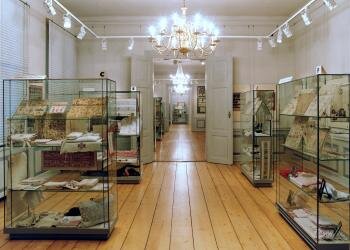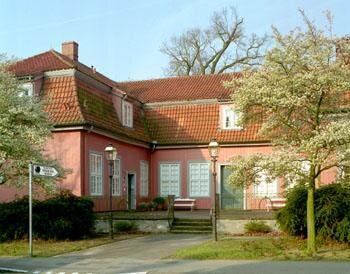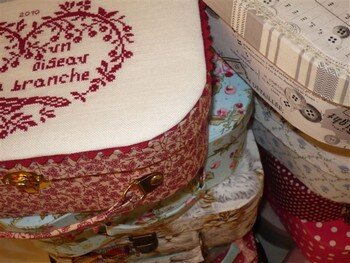Sampler Museum in Celle, Germany
Years ago I did cross stitch. My daughters each have their own Christmas stocking with a cross stitch border along the top. I had always thought of cross stitch as a very North American form of stitching. Well, I now know I was W.R.O.N.G.My first peek into the wider world of cross stitch happened a few years ago, when on a trip to a teacher's conference in Hannover, my husband and I stopped at the fabulous Sampler Museum in Celle, Germany. Although not all the work was done using cross stitch, quite a few pieces did use that stitch and I gained a new appreciation for that simple little X. The collection contains hundreds of samplers from all over Europe. The oldest piece in the collection comes from East Frisia. It's date is 1620. 1620! That's just shy of 400 years old. And I almost didn't get to see it!When we arrived, the lights were on but the door was locked. I knocked on the door, hoping that someone had forgotten to unlock it on a Saturday afternoon. Celle is a small town and I would not have been surprised to find someone inside, working and not really noticing that no one was coming in. I guessed that not many people ventured to Celle to see this amazing place. Embroiderers in the general population are few and far between.
The collection contains hundreds of samplers from all over Europe. The oldest piece in the collection comes from East Frisia. It's date is 1620. 1620! That's just shy of 400 years old. And I almost didn't get to see it!When we arrived, the lights were on but the door was locked. I knocked on the door, hoping that someone had forgotten to unlock it on a Saturday afternoon. Celle is a small town and I would not have been surprised to find someone inside, working and not really noticing that no one was coming in. I guessed that not many people ventured to Celle to see this amazing place. Embroiderers in the general population are few and far between. There was no answer after my first knock but I could see lights and heard voices so I pounded on the door. I really wanted to see this collection! Someone heard me for a few seconds later, the door opened and a woman with bright red hair greeted me. I explained that I wanted to see the collection and asked if they were open. No, she said, but she was giving a private tour and I was welcome to join them. I didn't hesitate and motioned to my husband to come inside with me. My German was still pretty basic and I needed a translator! (Steve speaks fluent German - how lucky am I?!)As the guide and owner of the collection showed us around, I was amazed at the beautiful work, much of it done in cross stitch. The colors were lovely and the detail on the finely woven linen was astounding. I couldn't take it all in during one visit so I asked Steve to find out when they would be open to the public so we could come back. Mrs. Connemann explained that she couldn't say when they would be open. It turned out that the city was experiencing financial trouble and the mayor had decided that paying the heat and electricity on the building that housed the Sampler Museum was an expense that should be eliminated. I was so grateful that we'd gone then, before it closed forever.I don't know if they have reopened the museum and next time we're in the area, I'll be calling the museum first to see if can visit again.One of the things that stayed with me from the visit were some really beautiful French samplers. When I came home I started to explore a French embroidery web site. The word in French for embroidery is broderie so I did an internet search and found loads of wonderful sites.I speak passable French and can read French more easily than I can read German (the sentence structure is more like English in French than it is in German). There were so many beautiful sites from France! This is where I discovered that the one kind of cross stitch I like very much is the French style of stitching with red thread on white or natural colored linen. There is something so charming about it.
There was no answer after my first knock but I could see lights and heard voices so I pounded on the door. I really wanted to see this collection! Someone heard me for a few seconds later, the door opened and a woman with bright red hair greeted me. I explained that I wanted to see the collection and asked if they were open. No, she said, but she was giving a private tour and I was welcome to join them. I didn't hesitate and motioned to my husband to come inside with me. My German was still pretty basic and I needed a translator! (Steve speaks fluent German - how lucky am I?!)As the guide and owner of the collection showed us around, I was amazed at the beautiful work, much of it done in cross stitch. The colors were lovely and the detail on the finely woven linen was astounding. I couldn't take it all in during one visit so I asked Steve to find out when they would be open to the public so we could come back. Mrs. Connemann explained that she couldn't say when they would be open. It turned out that the city was experiencing financial trouble and the mayor had decided that paying the heat and electricity on the building that housed the Sampler Museum was an expense that should be eliminated. I was so grateful that we'd gone then, before it closed forever.I don't know if they have reopened the museum and next time we're in the area, I'll be calling the museum first to see if can visit again.One of the things that stayed with me from the visit were some really beautiful French samplers. When I came home I started to explore a French embroidery web site. The word in French for embroidery is broderie so I did an internet search and found loads of wonderful sites.I speak passable French and can read French more easily than I can read German (the sentence structure is more like English in French than it is in German). There were so many beautiful sites from France! This is where I discovered that the one kind of cross stitch I like very much is the French style of stitching with red thread on white or natural colored linen. There is something so charming about it. One of my favorite sites to visit is the Le Point de Croix Bourguinon (the cross stitch Bourguinon). These people know how to have fun while stitching! They have classes, exhibits and go on tours to see embroidery all over Europe. There's a page of shops, some of which have online shops. However, the very best part of the whole site are the free patterns or Cadeaux - gifts. There are some that are complex and some that are simple but all are charming in the way that red and white cross stitch can be.I haven't done any cross stitch for a while, but I'm thinking I'll try one of these. Maybe for Christmas. I don't think it would ever be in a museum, but I'm sure while I'm stitching it, I'll be continuing the long unbroken thread of samplers and cross stitch pieces that have been worked through the years.
One of my favorite sites to visit is the Le Point de Croix Bourguinon (the cross stitch Bourguinon). These people know how to have fun while stitching! They have classes, exhibits and go on tours to see embroidery all over Europe. There's a page of shops, some of which have online shops. However, the very best part of the whole site are the free patterns or Cadeaux - gifts. There are some that are complex and some that are simple but all are charming in the way that red and white cross stitch can be.I haven't done any cross stitch for a while, but I'm thinking I'll try one of these. Maybe for Christmas. I don't think it would ever be in a museum, but I'm sure while I'm stitching it, I'll be continuing the long unbroken thread of samplers and cross stitch pieces that have been worked through the years.
